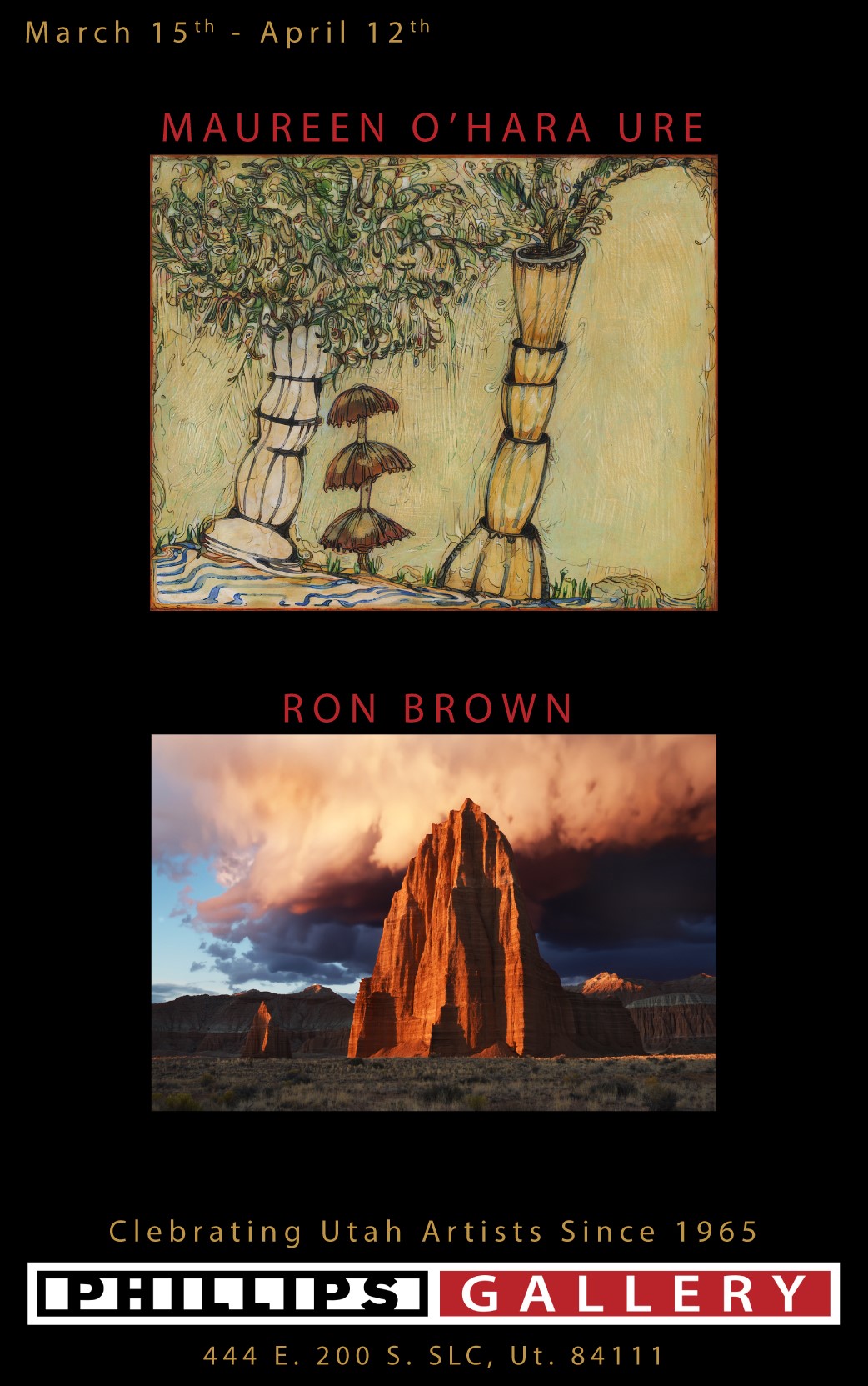An eerie, green glow shrouds numerous faces and figures with painted or printed veils. Bright swirls of colored oils make paths for flying silhouettes of birds. Those same birds are bound to a dark border of black ink, stopping them mid-flight.
In her show at Provo’s Writ and Vision, Greener on the Other Side, Kirsten Anderson aims to showcase “the converging space of opposing realities: abstract vs actual, reality vs fantasy, ignorance vs knowledge, life vs death.” The artist’s statement — hanging prominently in an arched entryway just past the books — emphasizes the color green as the meeting place of each duality. Green is described as the common factor portraying the fight and euphoria of discovering one’s personal balance, connection, and purpose.
“Gaze” does just that. A woman’s face — the realism of highlights and shadows in high contrast with the abstraction of her flat, black eyes — is completely covered in streaks of bright green pigment portraying a veil. While eyes are mirrors to the soul, her dead gaze creates a dissonance with her roseate complexion and evidence of life. Portraying her on linen emphasizes the painted veil, giving us further opportunity and depth of exploration. Is the veil separating her from reality? Protecting her from useless fantasy? Or is it keeping her in ignorance by distorting her vision and thus her perception? Whether a ward against evil, or the very cause of her troubles, it is left to the viewer to decide.
Three figures are grouped together by another green veil in “River Dream.” Anderson continues to use dark, flat eyes, but the faces in this work, like the abstract greens, blue, and black flowing colors behind them, remain flat. Though interestingly and skillfully designed, the beautiful conflict of contending realities seems to have been lost. A bird — a white silhouette — soars over a green and blue stream that sprouts from the top to the bottom of the right hand side of the painting. While the veil still evokes curiosity and reflection, as do the dark eyes, the other parts seem to bleed and merge into the other in an absence of reality and the actual.
As the show progresses, each oil painting or relief print seems to lose more and more of the actual and the real that Anderson wants to oppose to the abstract and fantastical. Figures seem to lose their legs and arms in swirls of greens, blues, and purples. Unfortunately, works like “The Fourth Dove” and “Flower Dream” do not show the same struggle of conflicting forces so adroitly portrayed in “Gaze.” A large, orange flower streaking like a shooting star through colorful clouds might call to mind Georgia O’Keeffe’s floral paintings, but with two eye-like shadows peaking through the petals, the mind more easily wanders to the singing flowers in Disney’s 1951 animated version of Alice in Wonderland. In these works the veils are missing, and we are left with only the fantastic abstraction of a dream that neither touches on life nor death, knowledge nor ignorance.
The exhibition fails to cohere adequately in other works: multiple dark reliefs on neutral colored linen scattered throughout the prominently green images discard color entirely. “Veiled Together” brings back the veil, the linen framed in such a way that the frayed edges show in stark contrast to the sharp graphic shapes of the print with the black frame holding it in place, so that we are able to enjoy the rivalry of dualities; but we do so at the expense of the unifying green color.
At first Anderson seems to be exploring three bodies of work in this exhibit: the green veils that beautifully convey the conflict between ignorance and knowledge and allude to the mysteries of life and death; the surreal visions of swirling figures in moving color accompanied by silhouetted doves that portray a dream-world that allows us to escape from reality; the black relief prints on neutral linen that present the opposition of rough edges to pristine frames, both literal and printed.
Each of these bodies of work may operate successfully in their own right, but they struggle within the overall framework of the exhibit. Perhaps these three conflicting mediums and presentations could be viewed as a further push toward Anderson’s intention? The actuality of color as a symbol is stripped away when the color is omitted, leaving a colorless abstract; the contemplation on the fantastic versus the tangible is hidden by surrealism, creating new conflict as the viewer searches for what isn’t there. The omission of realism from the work while the viewer is physically present, in reality, viewing that work.
Do these interpretations stand in contrast to the obvious and successful symbolism of the green veils, or do they support it? Greener on the Other Side successfully elicits a response. It pulls through preconceived notions and ideas, extending an invitation to carefully investigate intention, execution, and presentation.
Kirsten Anderson: Greener on the Other Side, Writ and Vision, Provo, through Mar. 25

Karilee Park is currently studying art education and the impact of an artistic identity. She creates using a variety of mediums such as drawing, poetry, and bursting into random song in public.
Categories: Exhibition Reviews | Visual Arts













